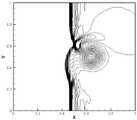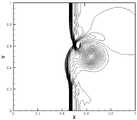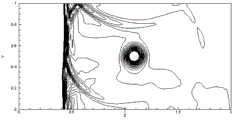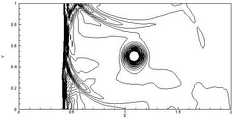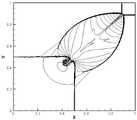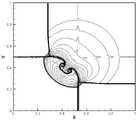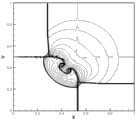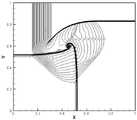CN108763683B - New WENO format construction method under trigonometric function framework - Google Patents
New WENO format construction method under trigonometric function frameworkDownload PDFInfo
- Publication number
- CN108763683B CN108763683BCN201810472192.4ACN201810472192ACN108763683BCN 108763683 BCN108763683 BCN 108763683BCN 201810472192 ACN201810472192 ACN 201810472192ACN 108763683 BCN108763683 BCN 108763683B
- Authority
- CN
- China
- Prior art keywords
- format
- tweno
- value
- time
- discrete
- Prior art date
- Legal status (The legal status is an assumption and is not a legal conclusion. Google has not performed a legal analysis and makes no representation as to the accuracy of the status listed.)
- Expired - Fee Related
Links
Images
Classifications
- G—PHYSICS
- G06—COMPUTING OR CALCULATING; COUNTING
- G06F—ELECTRIC DIGITAL DATA PROCESSING
- G06F30/00—Computer-aided design [CAD]
- G06F30/20—Design optimisation, verification or simulation
- G06F30/23—Design optimisation, verification or simulation using finite element methods [FEM] or finite difference methods [FDM]
- G—PHYSICS
- G06—COMPUTING OR CALCULATING; COUNTING
- G06F—ELECTRIC DIGITAL DATA PROCESSING
- G06F17/00—Digital computing or data processing equipment or methods, specially adapted for specific functions
- G06F17/10—Complex mathematical operations
- G06F17/15—Correlation function computation including computation of convolution operations
- G—PHYSICS
- G06—COMPUTING OR CALCULATING; COUNTING
- G06F—ELECTRIC DIGITAL DATA PROCESSING
- G06F2111/00—Details relating to CAD techniques
- G06F2111/10—Numerical modelling
- Y—GENERAL TAGGING OF NEW TECHNOLOGICAL DEVELOPMENTS; GENERAL TAGGING OF CROSS-SECTIONAL TECHNOLOGIES SPANNING OVER SEVERAL SECTIONS OF THE IPC; TECHNICAL SUBJECTS COVERED BY FORMER USPC CROSS-REFERENCE ART COLLECTIONS [XRACs] AND DIGESTS
- Y02—TECHNOLOGIES OR APPLICATIONS FOR MITIGATION OR ADAPTATION AGAINST CLIMATE CHANGE
- Y02T—CLIMATE CHANGE MITIGATION TECHNOLOGIES RELATED TO TRANSPORTATION
- Y02T90/00—Enabling technologies or technologies with a potential or indirect contribution to GHG emissions mitigation
Landscapes
- Engineering & Computer Science (AREA)
- Physics & Mathematics (AREA)
- General Physics & Mathematics (AREA)
- Theoretical Computer Science (AREA)
- Mathematical Physics (AREA)
- General Engineering & Computer Science (AREA)
- Mathematical Optimization (AREA)
- Pure & Applied Mathematics (AREA)
- Mathematical Analysis (AREA)
- Data Mining & Analysis (AREA)
- Computational Mathematics (AREA)
- Algebra (AREA)
- Software Systems (AREA)
- Databases & Information Systems (AREA)
- Computing Systems (AREA)
- Computer Hardware Design (AREA)
- Evolutionary Computation (AREA)
- Geometry (AREA)
- Complex Calculations (AREA)
- Management, Administration, Business Operations System, And Electronic Commerce (AREA)
Abstract
Translated fromChineseDescription
Translated fromChinese技术领域technical field
本发明属于计算流体力学工程技术领域,具体涉及了一种三角函数框架下新WENO格式构造方法。The invention belongs to the technical field of computational fluid dynamics engineering, and particularly relates to a new WENO format construction method under the framework of trigonometric functions.
背景技术Background technique
在工程应用中,流场问题常常出现,比如气体动力系统和浅水建模等。因此,制定解决这类问题的鲁棒的、精确的、高效的数值模拟方法至关重要,也吸引了很多研究者的兴趣。1959年,Godunov为解流场问题提出了一阶精度的数值模拟格式。一阶精度的数值模拟方法在捕捉激波时不会出现非物理的数值振荡但会过度抹平强间断,而往往强间断对问题的后续研究有着重要意义,因此需引进高精度数值计算格式模拟强间断类问题。In engineering applications, flow field problems often arise, such as gas dynamic systems and shallow water modeling. Therefore, it is crucial to develop robust, accurate, and efficient numerical simulation methods to solve such problems, which has attracted the interest of many researchers. In 1959, Godunov proposed a numerical simulation format with first-order accuracy for solving flow field problems. The numerical simulation method with first-order accuracy will not cause non-physical numerical oscillations when capturing shock waves, but will overly smooth out strong discontinuities, which are often of great significance to the follow-up research of the problem. Therefore, it is necessary to introduce high-precision numerical calculation formats for simulation. Strong discontinuity problem.
为了提高格式的精度,模拟解的结构以及准确的捕捉激波位置,Harten于1983年首次提出了TVD(Total Variation Diminishing)格式,并在此基础上与Osher于1987年提出了ENO(Essentially Non-Oscillatory)高精度格式。ENO格式的主要思想是在逐次扩展的模板中选用最光滑的模板构造多项式求出单元边界处的值,进而在光滑区域达到高阶精度、高分辨率,同时在间断附近实现基本无振荡的效果。但是,在方法的实现过程中,ENO格式最终只选用所有候选模板中最优的模板,造成计算结果的浪费,且构造的精度越高浪费的越多,导致计算效率不高。因此,Liu,Osher和Chan等于1994年提出了WENO(WeightedEssentially Non-oscillatory)格式,提高了计算结果的利用率并且使得r阶精度的ENO格式提高到r+1阶精度。1996年,Jiang和Shu进一步改善了WENO格式,使得数值精度能够提高到2r-1阶,并设计出新光滑因子和非线性权的构造框架。WENO格式的主要思想是通过低阶重构通量的线性凸组合获得高阶近似。但该经典WENO格式的实现过程中,线性权依赖于母模板,且其求解过程相当复杂,因此,2016年Zhu和Qiu改善了该WENO格式,在维持精度不减的情况下,随机选取大于零且总和为一的线性权。这些格式已被成功地用到很多应用领域,特别是包含激波和复杂解结构的问题,比如模拟可压缩湍流系统和空气声学系统等。In order to improve the accuracy of the format, simulate the structure of the solution and accurately capture the shock position, Harten first proposed the TVD (Total Variation Diminishing) format in 1983, and on this basis, together with Osher in 1987, proposed the ENO (Essentially Non- Oscillatory) high-precision format. The main idea of the ENO format is to select the smoothest template to construct the polynomial in the successively expanded templates to obtain the value at the element boundary, and then achieve high-order precision and high resolution in the smooth region, and at the same time achieve the effect of basically no oscillation near the discontinuity. . However, in the implementation process of the method, the ENO format finally only selects the optimal template among all the candidate templates, resulting in waste of calculation results, and the higher the construction accuracy, the more waste, resulting in low calculation efficiency. Therefore, Liu, Osher and Chan proposed the WENO (Weighted Essentially Non-oscillatory) format in 1994, which improved the utilization of the calculation results and made the r-order precision ENO format improved to r+1-order precision. In 1996, Jiang and Shu further improved the WENO scheme, so that the numerical accuracy can be increased to 2r-1 order, and designed a new smoothing factor and a construction framework for nonlinear weights. The main idea of the WENO scheme is to obtain a high-order approximation by a linear convex combination of the low-order reconstruction fluxes. However, in the implementation process of the classic WENO format, the linear weights depend on the master template, and the solution process is quite complicated. Therefore, in 2016, Zhu and Qiu improved the WENO format. While maintaining the accuracy, the random selection is greater than zero. and a linear weight that sums to one. These formats have been successfully used in many applications, especially problems involving shock waves and complex solution structures, such as modeling compressible turbulent systems and aeroacoustic systems.
波类和高频振荡类问题在工程应用中常常出现。然而,对模拟此类问题的更适合的三角函数多项式插值WENO格式的研究较少。虽然Baron于1976年研究三角函数插值呈现了Neville类方法,Muhlbach提出了牛顿三角函数插值,但是这些成果不能直接应用于ENO类插值格式。为此,Christofi于1996年提出了能直接用于ENO格式中的三角函数重构方法。Zhu和Qiu于2010年提出了用三角函数多项式重构WENO格式的方法,但计算复杂,不易实现。Wave-like and high-frequency oscillation problems often arise in engineering applications. However, less research has been done on the more suitable trigonometric polynomial interpolation WENO scheme for simulating such problems. Although Baron studied trigonometric function interpolation in 1976 and presented Neville-like methods, and Muhlbach proposed Newton's trigonometric function interpolation, these results cannot be directly applied to ENO-like interpolation formats. To this end, Christofi in 1996 proposed a trigonometric function reconstruction method that can be directly used in the ENO format. Zhu and Qiu in 2010 proposed a method to reconstruct the WENO format with trigonometric function polynomials, but the calculation is complex and difficult to implement.
发明内容SUMMARY OF THE INVENTION
本发明针对现有技术中的不足,提供一种三角函数框架下新WENO格式构造方法,能针对各种可压流场问题,进行高精度数值模拟。Aiming at the deficiencies in the prior art, the present invention provides a new WENO format construction method under the framework of trigonometric functions, which can perform high-precision numerical simulation for various compressible flow field problems.
为实现上述目的,本发明采用以下技术方案:To achieve the above object, the present invention adopts the following technical solutions:
一种三角函数框架下新WENO格式构造方法,在笛卡尔坐标系下,利用TWENO格式对可压流场问题进行数值模拟,其特征在于,包括以下步骤:A new WENO format construction method under the framework of trigonometric functions, in the Cartesian coordinate system, using the TWENO format to carry out numerical simulation of the compressible flow field problem, characterized in that the following steps are included:
步骤一、把双曲守恒律方程离散为空间半离散的有限差分格式,采用TWENO格式重构通量的近似值;
步骤二、对控制方程中的时间导数使用三阶TVD Runge-Kutta离散公式将半离散有限差分格式离散成时空全离散有限差分格式;
步骤三、根据时空全离散有限差分格式得到下一时间层上的近似值,依次迭代,得到计算区域内终止时刻流场的数值模拟值。Step 3: Obtain the approximate value on the next time layer according to the space-time fully discrete finite difference format, and iterate in turn to obtain the numerical simulation value of the flow field at the termination time in the calculation area.
为优化上述技术方案,采取的具体措施还包括:In order to optimize the above technical solutions, the specific measures taken also include:
所述步骤一中,双曲守恒律方程为:In the
其半离散格式的形式为:Its semi-discrete format is of the form:
其中,U=(ρ,ρu,E)T表示守恒变量,f(U)=(ρu,ρu2+p,u(E+p))T表示通量,Ut表示U对t求导,f(U)x表示f(U)对x求导,t表示时间变量,x表示空间变量,ρ、u、p、E分别表示流体密度、速度、压强、能量,T表示转置,U0表示初始状态值,L(U)表示-f(U)x的空间离散形式;Among them, U=(ρ,ρu,E)T is the conserved variable, f(U)=(ρu,ρu2 +p,u(E+p))T is the flux, Ut is the derivation of U with respect to t, f(U)x represents the derivative of f(U) with respect to x, t represents the time variable, x represents the space variable, ρ, u, p, and E represent the fluid density, velocity, pressure, and energy, respectively, T represents the transposition, U0 Represents the initial state value, L(U) represents the spatial discrete form of -f(U)x ;
把空间离散成统一长度的网格单元单元长度单元中心为其中i为坐标序号,有:Discretize space into grid cells of uniform length unit length The unit center is Where i is the coordinate number, there are:
其中,和分别表示通量f(U)在目标网格单元Ii的边界和处的五阶近似的数值通量,Ui(t)表示U在目标网格单元Ii内点xi处的值U(xi,t)。in, and respectively represent the flux f(U) at the boundary of the target grid cell Ii and The numerical flux of the fifth-order approximation at , Ui (t) represents the value U(xi ,t) of U at point xi in the target grid cell Ii .
所述步骤一中,求通量f(U)在目标网格单元Ii的边界和处的五阶近似值和具体步骤如下:In the
步骤1、采用Lax-Friedrichs分裂把通量分裂为其中,
步骤2、将目标网格单元Ii以及其周围共五个网格单元组成一个大模板T1=[Ii-2,Ii-1,Ii,Ii+1,Ii+2],从大模板中选择两个包含两个单元的小模板T2=[Ii-1,Ii]和T3=[Ii,Ii+1];
步骤3、在T1、T2、T3每个模板上分别重构三角函数多项式p1(x)、p2(x)和p3(x),使得:
p2(x),p3(x)∈span{1,sin(x-xi)};p2 (x),p3 (x)∈span{1,sin(xxi )};
步骤4、任意取三组线性权:
γ1=0.98,γ2=0.01,γ3=0.01;γ1 =0.98, γ2 =0.01, γ3 =0.01;
γ1=1/3,γ2=1/3,γ3=1/3;γ1 =1/3, γ2 =1/3, γ3 =1/3;
γ1=0.01,γ2=0.495,γ3=0.495;γ1 =0.01, γ2 =0.495, γ3 =0.495;
步骤5、计算光滑指示器βl,用于衡量重构多项式pl(x)在目标单元上的光滑度,计算公式为:Step 5. Calculate the smoothness indicator βl , which is used to measure the smoothness of the reconstructed polynomial pl (x) on the target unit. The calculation formula is:
其中,l=1,2,3表示对应模板序号,表示多项式pl(x)对x的α阶导数,r1=4,r2=1,r3=1;Among them, l=1,2,3 represents the corresponding template serial number, represents the α-order derivative of the polynomial pl (x) with respect to x, r1 =4, r2 =1, r3 =1;
步骤6、通过线性权γl和光滑指示器βl计算非线性权ωl,其计算公式为:Step 6. Calculate the nonlinear weight ωl through the linear weight γl and the smooth indicator βl , and the calculation formula is:
其中,τ为计算过程中的过渡值,ε=10-6;in, τ is the transition value in the calculation process, ε=10−6 ;
步骤7、求出数值通量分裂f+(U)在点处的TWENO重构值:Step 7. Find the numerical flux split f+ (U) at the point The reconstructed value of TWENO at:
同理,求出数值通量分裂f-(U)在点处的TWENO重构值、数值通量分裂f+(U)在点处的TWENO重构值、数值通量分裂f-(U)在点处的TWENO重构值;Similarly, find the numerical flux split f- (U) at the point TWENO reconstruction value at , numerical flux split f+ (U) at point TWENO reconstruction value at , numerical flux split f- (U) at point The reconstructed value of TWENO at ;
将计算结果代入含有时间导数项的半离散有限差分格式,得到关于时间导数的常微分方程。Substitute the calculation result into the semi-discrete finite difference scheme containing the time derivative term, and obtain the ordinary differential equation about the time derivative.
所述步骤3中,具体步骤如下:In the
步骤3.1、在三个模板T1、T2和T3上分别构造三角函数多项式p1(x)、p2(x)和p3(x),使其满足:Step 3.1. Construct trigonometric function polynomials p1 (x), p2 (x) and p3 (x) on the three templates T1 , T2 and T3 respectively, so that they satisfy:
步骤3.2、得到每个模板上的三角函数插值多项式p1(x)、p2(x)和p3(x),如下:Step 3.2. Obtain the trigonometric function interpolation polynomials p1 (x), p2 (x) and p3 (x) on each template, as follows:
其中,Ii-2、Ii-1、Ii、Ii+1、Ii+2分别表示第i-2、i-1、i、i+1、i+2个网格单元,fi+、分别表示f+(U)在点xi-2、xi-1、xi、xi+1、xi+2的值。Among them, Ii-2 , Ii-1 , Ii , Ii+1 , and Ii+2 represent the i-2, i-1, i, i+1, and i+2 grid cells, respectively, fi+ , represent the values of f+ (U) at points xi-2 , xi-1 , xi , xi+1 , and xi+2 , respectively.
所述步骤二中,利用三阶TVD Runge-Kutta离散公式:In the
得到时空全离散有限差分格式,其中,U(1),U(2)为中间过渡值,Δt为时间步长,上标n表示第n时间层,L(Un),L(U(1)),L(U(2))为-f(U)x的高阶空间离散形式的近似值。The space-time fully discrete finite difference scheme is obtained, where U(1) , U(2) are intermediate transition values, Δt is the time step, the superscript n represents the nth time layer, L(Un ), L(U(1 ) ), L(U(2) ) is an approximation of the higher-order spatial discrete form of -f(U)x .
所述步骤三中,时空全离散有限差分格式为关于时间层的迭代公式,初始状态值已知,通过迭代公式求出下一时间层的近似值,依次得到终止时刻计算区域内的数值模拟值。In the third step, the space-time fully discrete finite difference format is an iterative formula about the time layer, the initial state value is known, the approximate value of the next time layer is obtained through the iterative formula, and the numerical simulation value in the calculation area at the termination time is sequentially obtained.
本发明的有益效果是:相比于WENO格式,该TWENO格式通过把三角函数多项式而不是代数多项式作为有限差分TWENO格式的构建模块,模拟了波类和高频振荡类可压流场问题,同时在光滑区域能够达到高阶精度;相比于已有三角函数多项式重构格式,该TWENO格式得到的全局L1截断误差与L∞截断误差更小,同时也避免了在强激波和接触间断处产生非物理振荡,该新五阶TWENO格式中的相关线性权不再需要通过复杂的计算得到而是被设为和为一的任意正数,因此该新TWENO格式具有更简便更易拓展到高维空间的优势。The beneficial effects of the present invention are: compared with the WENO format, the TWENO format uses trigonometric function polynomials instead of algebraic polynomials as the building blocks of the finite-difference TWENO format to simulate the wave-like and high-frequency oscillation-like compressible flow field problems, and simultaneously High-order accuracy can be achieved in smooth regions; compared with the existing trigonometric function polynomial reconstruction schemes, the global L1 truncation error and L∞ truncation error obtained by the TWENO scheme are smaller, and it also avoids strong shock waves and contact discontinuities. where non-physical oscillations are generated, the relevant linear weights in the new fifth-order TWENO scheme no longer need to be obtained through complex calculations, but are set to any positive number whose sum is one, so the new TWENO scheme is simpler and easier to extend to high The advantage of dimensional space.
附图说明Description of drawings
图1a-1c是实施例一中的台阶问题,利用本发明的有限差分TWENO格式得到的密度等值线图,分别采用线性权①、②、③。Figures 1a-1c show the step problem in the first embodiment. The density contour map obtained by using the finite difference TWENO format of the present invention adopts
图2a-2c是实施例二中的双马赫问题,利用本发明的有限差分TWENO格式得到的密度等值线图,分别采用线性权①、②、③。Figures 2a-2c are the double Mach problem in the second embodiment. The density contour map obtained by using the finite difference TWENO format of the present invention adopts
图3a-3c是实施例三中的激波和涡流相互干扰问题,利用本发明的有限差分TWENO格式得到的t=0.35时的压强等值线图,分别采用线性权①、②、③。Figures 3a-3c are the problem of mutual interference between shock waves and eddy currents in the third embodiment. The pressure contour diagrams at t=0.35 are obtained by using the finite difference TWENO format of the present invention, and
图4a-4c是实施例三中的激波和涡流相互干扰问题,利用本发明的有限差分TWENO格式得到的t=0.6时的压强等值线图,分别采用线性权①、②、③。Figures 4a-4c illustrate the mutual interference problem between shock waves and eddy currents in the third embodiment. The pressure contour diagrams at t=0.6 are obtained by using the finite difference TWENO format of the present invention, using
图5a-5c是实施例三中的激波和涡流相互干扰问题,利用本发明的有限差分TWENO格式得到的t=0.8时的压强等值线图,分别采用线性权①、②、③。Figures 5a-5c are the problem of mutual interference between shock waves and eddy currents in the third embodiment. The pressure contour diagrams at t=0.8 are obtained by using the finite difference TWENO format of the present invention, and
图6a-6c是实施例四中初值条件为(19)的二维Euler黎曼问题,利用本发明的有限差分TWENO格式得到的t=0.25时的密度等值线图,分别采用线性权①、②、③。Figures 6a-6c are the two-dimensional Euler Riemann problem with the initial value condition (19) in the fourth embodiment, and the density contour plots at t=0.25 obtained by using the finite difference TWENO format of the present invention, respectively using linear weights① , ②, ③.
图7a-7c是实施例四中初值条件为(20)的二维Euler黎曼问题,利用本发明的有限差分TWENO格式得到的t=0.25时的密度等值线图,分别采用线性权①、②、③。Figures 7a-7c are the two-dimensional Euler Riemann problem with the initial value condition (20) in the fourth embodiment, and the density contour plots at t=0.25 obtained by using the finite difference TWENO format of the present invention, respectively adopting linear weights① , ②, ③.
图8a-8c是实施例四中初值条件为(21)的二维Euler黎曼问题,利用本发明的有限差分TWENO格式得到的t=0.3时的密度等值线图,分别采用线性权①、②、③。Figures 8a-8c are the two-dimensional Euler Riemann problem with the initial value condition (21) in the fourth embodiment, and the density contour plots at t=0.3 obtained by using the finite difference TWENO format of the present invention, respectively using linear weights① , ②, ③.
图9a-9c是实施例四中初值条件为(22)的二维Euler黎曼问题,利用本发明的有限差分TWENO格式得到的t=0.2时的密度等值线图,分别采用线性权①、②、③。Figures 9a-9c are the two-dimensional Euler Riemann problem with the initial value condition (22) in the fourth embodiment, and the density contour plots at t=0.2 obtained by using the finite difference TWENO format of the present invention, respectively adopting linear weights① , ②, ③.
图10a-10c是实施例四中初值条件为(23)的二维Euler黎曼问题,利用本发明的有限差分TWENO格式得到的t=0.3时的密度等值线图,分别采用线性权①、②、③。Figures 10a-10c are the two-dimensional Euler Riemann problem with the initial value condition (23) in the fourth embodiment, and the density contour plots at t=0.3 obtained by using the finite difference TWENO format of the present invention, respectively using linear weights① , ②, ③.
具体实施方式Detailed ways
现在结合附图对本发明作进一步详细的说明。The present invention will now be described in further detail with reference to the accompanying drawings.
本发明给出了笛卡尔网格下解可压流场问题的新型五阶有限差分TWENO高精度数值计算格式的构造过程,相比于经典WENO格式,该TWENO格式通过把重构的三角函数多项式而不是重构的代数多项式作为有限差分WENO格式的构建模块,解决了波类和高频振荡类的可压流场问题的数值模拟,且在光滑区域能够达到高阶精度近似,捕捉到尖锐和无振荡激波的转换。新的TWENO格式采用的线性权不再需要通过繁冗的数值计算得到,可设为满足和为一的任意正数,此格式方法简单、精度高,易于推广到多维空间中。该方法在笛卡尔坐标系下,利用TWENO格式对可压流场问题进行数值模拟,具体步骤如下:The invention provides the construction process of a new fifth-order finite difference TWENO high-precision numerical calculation format for solving the compressible flow field problem under Cartesian grid. The non-reconstructed algebraic polynomial is used as the building block of the finite-difference WENO format to solve the numerical simulation of compressible flow field problems of the wave type and high-frequency oscillation type, and can achieve high-order precision approximation in the smooth region, capturing sharp and non-linear Conversion of oscillatory shock waves. The linear weight adopted by the new TWENO format no longer needs to be obtained by tedious numerical calculation, and can be set to any positive number satisfying the sum of one. This method uses the TWENO format to numerically simulate the compressible flow field problem in the Cartesian coordinate system. The specific steps are as follows:
一、把双曲守恒律方程离散为空间半离散的有限差分格式,采用TWENO格式重构通量的近似值。1. Discrete the hyperbolic conservation law equation into a spatially semi-discrete finite difference scheme, and use the TWENO scheme to reconstruct the approximate value of the flux.
考虑一维双曲守恒律方程:Consider the one-dimensional hyperbolic conservation law equation:
其半离散格式的形式为:Its semi-discrete format is of the form:
其中,U=(ρ,ρu,E)T表示守恒变量,f(U)=(ρu,ρu2+p,u(E+p))T表示通量,Ut表示U对t求导,f(U)x表示f(U)对x求导,t表示时间变量,x表示空间变量,ρ、u、p、E分别表示流体密度、速度、压强、能量,T表示转置,U0表示初始状态值,L(U)表示-f(U)x的空间离散形式。Among them, U=(ρ,ρu,E)T is the conserved variable, f(U)=(ρu,ρu2 +p,u(E+p))T is the flux, Ut is the derivation of U with respect to t, f(U)x represents the derivative of f(U) with respect to x, t represents the time variable, x represents the space variable, ρ, u, p, and E represent the fluid density, velocity, pressure, and energy, respectively, T represents the transposition, U0 represents the initial state value, and L(U) represents the spatially discrete form of -f(U)x .
把空间离散成统一长度的网格单元单元长度单元中心为其中i为坐标序号,有:Discretize space into grid cells of uniform length unit length The unit center is Where i is the coordinate number, there are:
其中,和分别表示通量f(U)在目标单元Ii的边界和处的五阶近似的数值通量,Ui(t)表示U在网格单元Ii内点xi处的值U(xi,t)。in, and respectively represent the flux f(U) at the boundary of the target cell Ii and The numerical flux of the fifth-order approximation at , Ui (t) represents the value U(xi ,t) of U at point xi in grid cell Ii .
求通量f(U)在目标单元Ii的边界和处的五阶近似值和具体步骤如下:Find the flux f(U) at the boundary of the target cell Ii and fifth-order approximation at and Specific steps are as follows:
步骤1、用最简单的Lax-Friedrichs分裂把通量分裂为其中为了简单起见,本发明只描述f+(U)在点处的重构过程并将其定义为
步骤2、将目标单元Ii以及其周围共5个网格单元组成一个大模板T1=[Ii-2,Ii-1,Ii,Ii+1,Ii+2],从大模板中选择两个包含两个单元的小模板T2=[Ii-1,Ii]和T3=[Ii,Ii+1],其中Ii为对应序号的网格单元。
步骤3、在每个模板上分别重构三角函数多项式p1(x)、p2(x)和p3(x),使得:
p2(x),p3(x)∈span{1,sin(x-xi)}。p2 (x),p3 (x)∈span{1,sin(xxi )}.
其具体过程如下:The specific process is as follows:
步骤3.1、在三个模板T1、T2和T3上分别构造三角函数多项式p1(x)、p2(x)和p3(x),使其满足:Step 3.1. Construct trigonometric function polynomials p1 (x), p2 (x) and p3 (x) on the three templates T1 , T2 and T3 respectively, so that they satisfy:
步骤3.2、得到每个模板上的三角函数插值多项式p1(x)、p2(x)和p3(x),如下:Step 3.2. Obtain the trigonometric function interpolation polynomials p1 (x), p2 (x) and p3 (x) on each template, as follows:
其中,Ii-2、Ii-1、Ii、Ii+1、Ii+2分别表示第i-2、i-1、i、i+1、i+2个单元,fi+、分别表示f+(U)在点xi-2、xi-1、xi、xi+1、xi+2的值,h为网格步长。Wherein, Ii-2 , Ii-1 , Ii , Ii+1 , and Ii+2 represent the i-2, i-1, i, i+1, and i+2 units, respectively, fi+ , respectively represent the values of f+ (U) at points xi-2 , xi-1 , xi , xi+1 , and xi+2 , and h is the grid step size.
步骤4、任意取三组线性权:
①γ1=0.98,γ2=0.01,γ3=0.01;①γ1 =0.98, γ2 =0.01, γ3 =0.01;
②γ1=1/3,γ2=1/3,γ3=1/3;②γ1 =1/3, γ2 =1/3, γ3 =1/3;
③γ1=0.01,γ2=0.495,γ3=0.495。③ γ1 =0.01, γ2 =0.495, γ3 =0.495.
步骤5、计算光滑指示器βl,用于衡量重构多项式pl(x)在目标单元上的光滑度,计算公式为:Step 5. Calculate the smoothness indicator βl , which is used to measure the smoothness of the reconstructed polynomial pl (x) on the target unit. The calculation formula is:
其中,l=1,2,3表示对应模板序号,表示多项式pl(x)对x的α阶导数,r1=4,r2=1,r3=1。Among them, l=1,2,3 represents the corresponding template serial number, Represents the alpha derivative of the polynomial pl (x) with respect to x, where r1 =4, r2 =1, and r3 =1.
步骤6、通过线性权γl和光滑指示器βl计算非线性权ωl,其计算公式为:Step 6. Calculate the nonlinear weight ωl through the linear weight γl and the smooth indicator βl , and the calculation formula is:
其中,l=1,2,3表示对应模板序号,τ为计算过程中的过渡值,βl为光滑指示器,ε=10-6防止分母为零。Among them, l=1,2,3 represents the corresponding template serial number, τ is the transition value in the calculation process, βl is the smoothness indicator, and ε=10−6 prevents the denominator from being zero.
步骤7、求出数值通量分裂f+(U)在点处的TWENO重构值:Step 7. Find the numerical flux split f+ (U) at the point The reconstructed value of TWENO at:
其次,将计算结果代入含有时间导数项的半离散有限差分格式,得到关于时间导数的常微分方程。Secondly, the calculation result is substituted into the semi-discrete finite difference scheme containing the time derivative term, and the ordinary differential equation about the time derivative is obtained.
二、对控制方程中的时间导数使用三阶TVD Runge-Kutta离散公式将半离散有限差分格式离散成时空全离散有限差分格式。2. Using the third-order TVD Runge-Kutta discrete formula to discretize the semi-discrete finite-difference format into a space-time fully discrete finite-difference format for the time derivative in the control equation.
利用三阶TVD Runge-Kutta离散公式:Using the third-order TVD Runge-Kutta discrete formula:
得到时空全离散有限差分格式,其中,U(1),U(2)为中间过渡值,Δt为时间步长,上标n表示第n时间层,L(Un),L(U(1)),L(U(2))为-f(U)x的高阶空间离散形式的近似值。The space-time fully discrete finite difference scheme is obtained, where U(1) , U(2) are intermediate transition values, Δt is the time step, the superscript n represents the nth time layer, L(Un ), L(U(1 ) ), L(U(2) ) is an approximation of the higher-order spatial discrete form of -f(U)x .
三、根据时空全离散有限差分格式得到下一时间层上的近似值,依次迭代,得到计算区域内终止时刻流场的数值模拟值。3. Obtain the approximate value on the next time layer according to the space-time fully discrete finite difference scheme, and iterate in turn to obtain the numerical simulation value of the flow field at the termination time in the calculation area.
时空全离散有限差分格式为关于时间层的迭代公式,初始状态值已知,通过迭代公式求出下一时间层的近似值,依次得到终止时刻计算区域内的数值模拟值。对于二维问题,逐维用上面的重构过程。The space-time fully discrete finite difference scheme is an iterative formula about the time layer, the initial state value is known, the approximate value of the next time layer is obtained through the iterative formula, and the numerical simulation value in the calculation area at the termination time is obtained in turn. For two-dimensional problems, use the above reconstruction process dimension by dimension.
下面给出几个算例作为本发明所公开方法的具体实施例。Several calculation examples are given below as specific embodiments of the method disclosed in the present invention.
实施例一、台阶问题。该问题是Emery于1968年提出的一个用于检验非线性双曲型守恒律格式的经典算例。初始数据为水平来流马赫数为3,密度为1.4,水平速度为3,竖直速度为0,压强为1,管道区域为[0,3]×[0,1],在距离左边界0.6处有一高度为0.2的台阶,且台阶延伸到管道的尽头。上下边界为反射边界,左边界为来流边界,右边界为出流边界。图1a-1c给出了t=4时的密度等值线图。
实施例二、双马赫反射问题。该问题描述了一个与x轴成60°角的强激波射到反射墙上发生的变化,来流是马赫数为10的强激波。计算区域为[0,4]×[0,1]。区域底部从y=0处开始为反射边界条件,其它的底部边界(从x=0到那部分)为波前条件。图2a-2c给出了t=0.2时在[0,3]×[0,1]区域的密度等值线图。
实施例三、激波和涡流相互干扰问题。马赫数为1.1的激波位于x=0.5处且垂直于x轴。激波初始状态是小涡流位于该激波的左边且其中心位于(xc,yc)=(0.25,0.5)处。涡流可看成平均流的速度,温度和熵的扰动,表示为:
其中,τ=r/rc,ε=0.3,rc=0.05,α=0.204,γ=1.4,计算区域为[0,2]×[0,1]。图3a-3c给出了t=0.35时在[0,1]×[0,1]区域的压强等值线图。图4a-4c给出了t=0.6时在[0.4,1.45]×[0,1]区域的压强等值线图。图5a-5c给出了t=0.8时在[0,2]×[0,1]区域的压强等值线图。where τ=r /rc , ε=0.3,rc =0.05, α=0.204, γ=1.4, and the calculation area is [0,2]×[0,1]. Figures 3a-3c show the pressure contour plots in the [0,1]×[0,1] region at t=0.35. Figures 4a-4c show the pressure contour plots in the [0.4, 1.45] × [0, 1] region at t=0.6. Figures 5a-5c show the pressure contour plots in the [0,2]×[0,1] region at t=0.8.
实施例四、二维Euler黎曼问题。计算区域为[0,1]×[0,1],初值条件分别设为:
图6a-6c给出了初值条件为(18)时二维Euler黎曼问题在t=0.25时刻的密度等值线图。图7a-7c给出了初值条件为(19)时二维Euler黎曼问题在t=0.25时刻的密度等值线图。图8a-8c给出了初值条件为(20)时二维Euler黎曼问题在t=0.3时刻的密度等值线图。图9a-9c给出了初值条件为(21)时二维Euler黎曼问题在t=0.2时刻的密度等值线图。图10a-10c给出了初值条件为(22)时二维Euler黎曼问题在t=0.3时刻的密度等值线图。从图中可以看出基于三角函数多项式空间的有限差分TWENO格式对本发明任意取得的线性权都可以很好的捕捉到黎曼问题的大部分流动特性。Figures 6a-6c show the density contour map of the two-dimensional Euler-Riemann problem at t=0.25 when the initial value condition is (18). Figures 7a-7c show the density contour map of the two-dimensional Euler-Riemann problem at t=0.25 when the initial value condition is (19). Figures 8a-8c show the density contour map of the two-dimensional Euler-Riemann problem at t=0.3 when the initial value condition is (20). Figures 9a-9c show the density contour map of the two-dimensional Euler-Riemann problem at t=0.2 when the initial value condition is (21). Figures 10a-10c show the density contour plots of the two-dimensional Euler-Riemann problem at t=0.3 when the initial value condition is (22). It can be seen from the figure that the finite difference TWENO scheme based on the trigonometric function polynomial space can well capture most of the flow characteristics of the Riemann problem for any linear weight obtained by the present invention.
以上仅是本发明的优选实施方式,本发明的保护范围并不仅局限于上述实施例,凡属于本发明思路下的技术方案均属于本发明的保护范围。应当指出,对于本技术领域的普通技术人员来说,在不脱离本发明原理前提下的若干改进和润饰,应视为本发明的保护范围。The above are only preferred embodiments of the present invention, and the protection scope of the present invention is not limited to the above-mentioned embodiments, and all technical solutions that belong to the idea of the present invention belong to the protection scope of the present invention. It should be pointed out that for those skilled in the art, some improvements and modifications without departing from the principle of the present invention should be regarded as the protection scope of the present invention.
Claims (4)
Priority Applications (2)
| Application Number | Priority Date | Filing Date | Title |
|---|---|---|---|
| CN201810472192.4ACN108763683B (en) | 2018-05-16 | 2018-05-16 | New WENO format construction method under trigonometric function framework |
| CN202210373696.7ACN114757070B (en) | 2018-05-16 | 2018-05-16 | A new WENO format construction method for numerical simulation based on trigonometric function framework |
Applications Claiming Priority (1)
| Application Number | Priority Date | Filing Date | Title |
|---|---|---|---|
| CN201810472192.4ACN108763683B (en) | 2018-05-16 | 2018-05-16 | New WENO format construction method under trigonometric function framework |
Related Child Applications (1)
| Application Number | Title | Priority Date | Filing Date |
|---|---|---|---|
| CN202210373696.7ADivisionCN114757070B (en) | 2018-05-16 | 2018-05-16 | A new WENO format construction method for numerical simulation based on trigonometric function framework |
Publications (2)
| Publication Number | Publication Date |
|---|---|
| CN108763683A CN108763683A (en) | 2018-11-06 |
| CN108763683Btrue CN108763683B (en) | 2022-04-01 |
Family
ID=64008294
Family Applications (2)
| Application Number | Title | Priority Date | Filing Date |
|---|---|---|---|
| CN202210373696.7AActiveCN114757070B (en) | 2018-05-16 | 2018-05-16 | A new WENO format construction method for numerical simulation based on trigonometric function framework |
| CN201810472192.4AExpired - Fee RelatedCN108763683B (en) | 2018-05-16 | 2018-05-16 | New WENO format construction method under trigonometric function framework |
Family Applications Before (1)
| Application Number | Title | Priority Date | Filing Date |
|---|---|---|---|
| CN202210373696.7AActiveCN114757070B (en) | 2018-05-16 | 2018-05-16 | A new WENO format construction method for numerical simulation based on trigonometric function framework |
Country Status (1)
| Country | Link |
|---|---|
| CN (2) | CN114757070B (en) |
Families Citing this family (10)
| Publication number | Priority date | Publication date | Assignee | Title |
|---|---|---|---|---|
| CN110069854A (en)* | 2019-04-22 | 2019-07-30 | 南京航空航天大学 | Multiple resolution TWENO format is to the analogy method that can press flow field problems |
| CN110781626A (en)* | 2019-10-31 | 2020-02-11 | 南京航空航天大学 | Simulation Method of Finite Difference Multiresolution Trigonometric Function WENO Scheme |
| CN111159956B (en)* | 2019-12-10 | 2021-10-26 | 北京航空航天大学 | Feature-based flow field discontinuity capturing method |
| CN111177965B (en)* | 2019-12-25 | 2022-06-17 | 南京航空航天大学 | A fixed-point fast scan method based on multi-resolution WENO format for solving steady-state problems |
| CN111563314B (en)* | 2020-03-23 | 2023-09-12 | 空气动力学国家重点实验室 | Seven-point WENO format construction method |
| CN111859819B (en)* | 2020-06-16 | 2024-09-06 | 空气动力学国家重点实验室 | Construction method of high-order WENO format |
| CN112163312B (en)* | 2020-08-17 | 2022-08-02 | 空气动力学国家重点实验室 | A Method for Numerical Simulation of Compressible Flow Problems by Order Reduction of Higher-Order WENO Schemes |
| CN112100835B (en)* | 2020-09-06 | 2022-06-14 | 西北工业大学 | A high-efficiency and high-precision numerical simulation method for airfoil flow around an airfoil suitable for complex flow |
| CN114707254B (en)* | 2022-06-01 | 2022-08-26 | 中国空气动力研究与发展中心计算空气动力研究所 | Two-dimensional boundary layer grid generation method and system based on template construction method |
| CN118446133B (en)* | 2024-05-20 | 2024-10-15 | 重庆大学 | New TVD format construction method based on from format |
Citations (2)
| Publication number | Priority date | Publication date | Assignee | Title |
|---|---|---|---|---|
| CN104091065A (en)* | 2014-07-03 | 2014-10-08 | 南京信息工程大学 | Intermittent flow numerical simulation method for solving shallow water problem |
| CN107220399A (en)* | 2017-03-23 | 2017-09-29 | 南京航空航天大学 | Weight the whole flow field analogy method of non-oscillatory scheme substantially based on Hermite interpolation |
Family Cites Families (1)
| Publication number | Priority date | Publication date | Assignee | Title |
|---|---|---|---|---|
| WO2014043846A1 (en)* | 2012-09-18 | 2014-03-27 | Lu Ming | Numerical method for solving two-dimensional riemannian problem to simulate subsonic non-viscous stream |
- 2018
- 2018-05-16CNCN202210373696.7Apatent/CN114757070B/enactiveActive
- 2018-05-16CNCN201810472192.4Apatent/CN108763683B/ennot_activeExpired - Fee Related
Patent Citations (2)
| Publication number | Priority date | Publication date | Assignee | Title |
|---|---|---|---|---|
| CN104091065A (en)* | 2014-07-03 | 2014-10-08 | 南京信息工程大学 | Intermittent flow numerical simulation method for solving shallow water problem |
| CN107220399A (en)* | 2017-03-23 | 2017-09-29 | 南京航空航天大学 | Weight the whole flow field analogy method of non-oscillatory scheme substantially based on Hermite interpolation |
Non-Patent Citations (6)
| Title |
|---|
| "New Finite Volume Weighted Essentially Nonoscillatory Schemes on Triangular Meshes";Jun Zhu et al.;《SIAM Journal on Scientific Computing》;20180131;第1-36页* |
| "A new fifth order finite difference WENO scheme for solving hyperbolic conservation laws";Jun Zhu et al.;《Journal of Computational Physics》;20160507;第110-121页* |
| "Trigonometric WENO Schemes for Hyperbolic Conservation Laws and Highly Oscillatory Problems";Jun Zhu et al.;《Communications in Computational Physics》;20101130;第1-32页* |
| "加权基本无振荡格式研究进展";赵海洋等;《力学季刊》;20050331;第26卷(第1期);第87-95页* |
| "返回舱动态稳定性物理机理分析及被动/主动控制方法研究";赵海洋;《中国博士学位论文全文数据库》;20090715;第1-152页* |
| "高精度WENO格式在三维外流场计算中的应用";刘耀峰等;《弹箭与制导学报》;20051231;第25卷(第3期);第81-83页* |
Also Published As
| Publication number | Publication date |
|---|---|
| CN108763683A (en) | 2018-11-06 |
| CN114757070A (en) | 2022-07-15 |
| CN114757070B (en) | 2025-01-28 |
Similar Documents
| Publication | Publication Date | Title |
|---|---|---|
| CN108763683B (en) | New WENO format construction method under trigonometric function framework | |
| CN107220399A (en) | Weight the whole flow field analogy method of non-oscillatory scheme substantially based on Hermite interpolation | |
| Dhatt et al. | Finite element method | |
| CN104298869B (en) | A Numerical Prediction Method for Fluid-Structure Interaction Characteristics of Elastic Hydrofoils | |
| Walko et al. | The ocean–land–atmosphere model (OLAM). Part I: Shallow-water tests | |
| Shapiro et al. | Geometric issues in computer aided design/computer aided engineering integration | |
| CN112100835B (en) | A high-efficiency and high-precision numerical simulation method for airfoil flow around an airfoil suitable for complex flow | |
| CN109726465B (en) | Three-dimensional non-adhesive low-speed streaming numerical simulation method based on non-structural curved edge grid | |
| CN108280273B (en) | A Numerical Calculation Method of Finite Volume Flow Field Based on Non-equidistant Grid | |
| CN110457806A (en) | Full flow field simulation method based on staggered grid with central fifth-order WENO scheme | |
| Samulyak et al. | Lagrangian particle method for compressible fluid dynamics | |
| CN110069854A (en) | Multiple resolution TWENO format is to the analogy method that can press flow field problems | |
| CN105760602A (en) | Total flow field numerical simulation method for finite volume weighted essentially non-oscillatory scheme | |
| CN109657408A (en) | A kind of regeneration nuclear particle algorithm realization linear static numerical simulation method of structure | |
| CN116702571B (en) | Numerical simulation method and device based on multiple smoothness measurement factors | |
| CN115828782A (en) | Fluid-solid coupling numerical simulation method based on lattice Boltzmann flux algorithm | |
| CN104268322A (en) | Boundary processing technology of WENO difference method | |
| CN112307684B (en) | A fixed-point fast scanning method based on multi-resolution WENO format combined with ILW boundary processing | |
| Yang et al. | Gas kinetic flux solver based high-order finite-volume method for simulation of two-dimensional compressible flows | |
| CN117634049A (en) | A ship navigation flow field simulation method, device, equipment and storage medium | |
| Abouri et al. | A stable Fluid-Structure-Interaction algorithm: Application to industrial problems | |
| CN110909511B (en) | A Numerical Simulation Method of Inviscid Low Velocity Flow Around No Surface Volume | |
| Khalighi et al. | Investigation of fluid-structure interaction by explicit central finite difference methods | |
| Felici et al. | Analysis of vortex induced vibration of a thermowell by high fidelity FSI numerical analysis based on RBF structural modes embedding | |
| Moreira et al. | Implicit spectral difference method solutions of compressible flows considering high-order meshes |
Legal Events
| Date | Code | Title | Description |
|---|---|---|---|
| PB01 | Publication | ||
| PB01 | Publication | ||
| SE01 | Entry into force of request for substantive examination | ||
| SE01 | Entry into force of request for substantive examination | ||
| GR01 | Patent grant | ||
| GR01 | Patent grant | ||
| CF01 | Termination of patent right due to non-payment of annual fee | Granted publication date:20220401 | |
| CF01 | Termination of patent right due to non-payment of annual fee |






